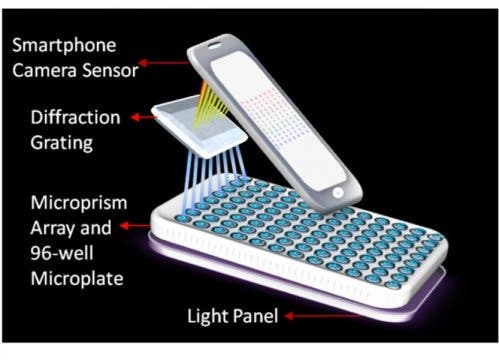A Washington State University team has created a portable, low-cost smartphone lab which can analyze several samples at once for a cancer biomarker.
Waiting for your medical results can be a harrowing experience. All you know is that you’ve been to the doctor when something in your body went wrong. Now you have to wait, powerless, for a phone call that could set you free from worry or thrust your next few years in a jumble of tests, procedures, and medication. Even if it turns out to be nothing, that waiting time will feel like hell on earth.
Especially with cancer.
Now, a WSU team lead by Lei Li, assistant professor in the School of Mechanical and Materials Engineering, brought the technology used in lab settings to an average smartphone, to offer on the spot cancer tests to doctors’ offices, ambulances, and the ER. Their system consists of an eight-channel smartphone spectrometer which can pick up on human interleukin-6 (IL-6), a biomarker for a host of cancers.
It’s not the first smartphone spectrometer out there, but previous versions could only measure one sample at a time, making them too slow for field applications. The WSU multichannel device can analyze up to eight different samples at once using a test known as ELISA — colorimetric test enzyme-linked immunosorbent assay. This has been described as the “gold standard clinical diagnostic tool for the detection and quantification of protein biomarkers,” (Thiha A., Ibrahim F., 2015), and it uses antibodies and color change to identify a substance.
“With our eight channel spectrometer, we can put eight different samples to do the same test, or one sample in eight different wells to do eight different tests. This increases our device’s efficiency,” said Li, who has filed a provisional patent for the work.
After testing the device with standard lab-controlled samples, the WSU device achieved up to 99% accuracy. The researchers are hopeful it will be just as reliable in the field, and have started applying the portable spectrometer in real world cases.
“The spectrometer would be especially useful in clinics and hospitals that have a large number of samples without on-site labs, or for doctors who practice abroad or in remote areas,” he said. “They can’t carry a whole lab with them. They need a portable and efficient device.”
Right now, Li’s spectrometer is available only for the iPhone 5. He said the team is working on making the design compatible with any smartphone.
A paper describing the device titled “A multichannel smartphone optical biosensor for high-throughput point-of-care diagnostics” has been published in the journal Biosensors and Bioelectronics.










